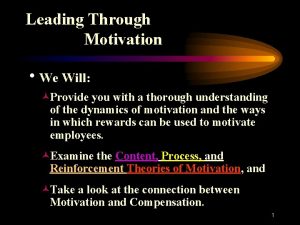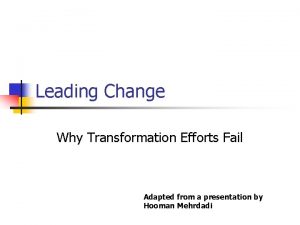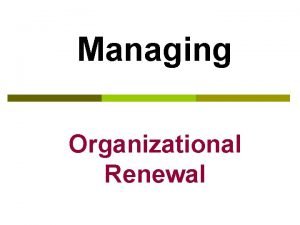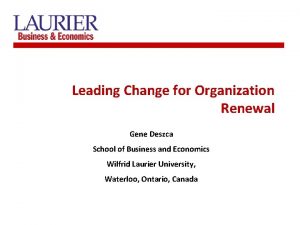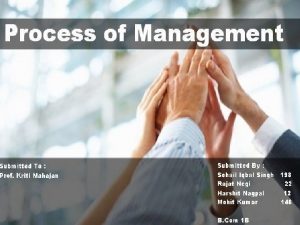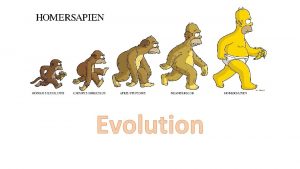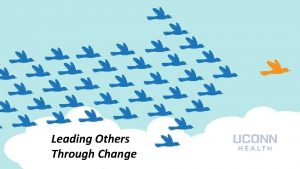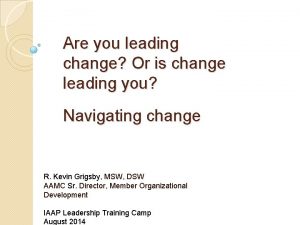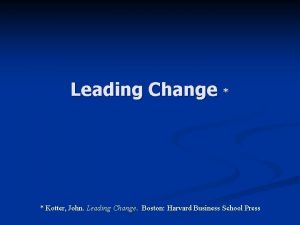Leading Others Through Change A ThreePhase Model for



































































































- Slides: 99

Leading Others Through Change A Three-Phase Model for Success Elaine Biech Supplemental Self-Study Presentation

Leading Others Through Change: A Three-Phase Model for Success Overview

Leading Others Through Change: A Three-Phase Model for Success Introduction Change is here to stay. That’s probably no secret to you. For years we’ve all heard that the “only constant is change. ” Change is present in every aspect of your life and has become the norm in all organizations. The frequency and pace at which leaders must ask employees to change course or adapt to new systems and initiatives continues to accelerate. The word “crisis” in the Chinese language is composed of two characters: one represents danger and the other represents opportunity. Change has the same negative and positive connotation. It can be antagonistic, undesirable, and perilous; or it can be pleasant, welcomed, and exciting. It is a leader’s job to identify the positive prospects and communicate the opportunity that change imposes upon the organization. “Security is mostly a superstition. It does not exist in nature. Avoiding danger is no safer in the long run than outright exposure. Life is either a daring adventure or nothing. ” —Helen Keller

Leading Others Through Change: A Three-Phase Model for Success Introduction Part 2 Leading others through change successfully requires thoughtful planning and innovative options. This course will provide you with a clearer understanding of what happens to people when an organizational change initiative occurs. It also introduces the tools and techniques you can use to more effectively lead change efforts in your organization, ultimately allowing you to leave the course feeling better prepared to address the myriad of changes that come your way. “Why not go out on a limb? That’s where the fruit is. ” —Will Rogers

Leading Others Through Change: A Three-Phase Model for Success Module 1: Explore the Change

Leading Others Through Change: A Three-Phase Model for Success What Causes Change Efforts to Fail? A number of sources state that change fails more often than it succeeds. John Kotter, for example in his book, A Sense of Urgency, states that his experience demonstrates change fails “more than 70 percent” of the time. Other authors have made similar claims that range from 40 to 80 percent. While there is a broad numeric choice, it isn’t the number that is critical. It is more important to explore why this occurs. There are many reasons that change is not completely successful. The costs associated with failed change are staggering. While the root causes vary widely, these are some of the top reasons why change efforts fail: • Need for change is unclear • Complacency overcomes urgency • Resistance is unexpected and mismanaged • Communication is limited • Lack of employee commitment throughout the organization • Lack of accurate and comprehensive information

Leading Others Through Change: A Three-Phase Model for Success What Helps Change Efforts to Succeed? As you might imagine from your own experiences, communication tops the list of reasons for success. In addition to excellent communication, successful change occurs with: • A clear vision • Leadership support and involvement • Employee contribution and buy-in • Accountability • Alignment with organizational goals and values • Excellent communication

Leading Others Through Change: A Three-Phase Model for Success ACT to Lead Change produces lasting, successful results with adequate planning, thoughtful implementation, and accountable institutionalization. Each of these requires a knowledgeable and skilled change agent to lead the effort. To lead others through change requires a leader to ACT: • Activate the change • Create a plan • Transition the change The ACT Model (on the following slide) will help you remember all of the steps of implementing a successful change effort. The remainder of this course will provide you with tips and tools to address each step.

Leading Others Through Change: A Three-Phase Model for Success ACT to Lead Change Part 2 Activate the Change • Clarify and align the vision and goals • Determine readiness • Establish a sense of urgency • Establish a communication plan Create a Plan Transition the Change • Gather and analyze data • Plan to manage resistance • Involve and engage others Transition the Change • Design the implementation • Institutionalize the changes • Evaluate the effort

Leading Others Through Change: A Three-Phase Model for Success Rate Yourself Let’s assess what you think you need to do to ACT as a change leader. The ACT model provides a framework for you to initiate, plan, and implement your next successful change effort. This assessment will help you to rate your ability in leading successful change efforts. Instructions: Consider how well each statement describes you using a scale of 1 to 5, with “ 1” being not at all and “ 5” being a very good description. Statement Rating Activate the Change 1. I am adept at clarifying a vision and ensuring both the vision and goals are aligned with the organization. 2. I am able to determine the readiness of the organization and employees. 3. I understand how to establish a sense of urgency. 1 2 3 4 5 4. I always create a communication plan that provides the right information to the right people at the right time. 1 2 3 4 5

Leading Others Through Change: A Three-Phase Model for Success Rate Yourself Part 2 Statement Rating Create a Plan 5. I am proficient at gathering and analyzing data required for a change effort. 6. I am experienced with managing resistance. 7. I know how to create opportunities for involving and engaging the workforce. Statement 1 2 3 4 5 Rating Transition the Change 8. I am experienced with designing an action plan that implements change efforts. 1 2 3 4 5 9. I am capable of identifying and targeting all elements required to institutionalize change efforts. 1 2 3 4 5 10. I am skilled with evaluating the results of change efforts. 1 2 3 4 5

Leading Others Through Change: A Three-Phase Model for Success Rate Yourself Part 3 Answer the following questions to interpret your ratings. 1. Which statements described you well (ratings of 4 and 5)? These are your strengths. 2. Which statements described you least well (ratings of 1 and 2)? These are the skills you will want to improve. 3. In which phase (Activate the Change, Create a Plan, Transition the Change) did you choose the most 4 s and 5 s? This is your strongest area. 4. In which phase did you choose the most 1 s and 2 s? This is the area you will want to improve. 5. How can you use your strengths to improve your other skills? “It is in times of change that leadership is required most. ” —General Colin Powell

Leading Others Through Change: A Three-Phase Model for Success Test Your Knowledge Read the question, then click on the answer. Which of the following activities should occur during the Activate the Change phase? A. Establish a sense of urgency B. Gather and analyze data C. Involve and engage others D. Institutionalize the changes

Leading Others Through Change: A Three-Phase Model for Success Module 2: Activate the Change

Leading Others Through Change: A Three-Phase Model for Success Clarify and Align the Vision and Goals This module addresses the first phase of the ACT model, Activate the Change, and it has four steps. The first is to clarify and align the vision and goals. There are many tactics for clarifying and aligning the vision and goals of the change effort. In some cases you may need to facilitate the process of creating the vision. Nothing, however, is more important than communicating that vision to employees. A clear vision helps employees see the purpose and advantages of the change effort, and it is your job to help them to understand the vision. A clear vision also helps them see the end state and to think and act in a way that supports the ultimate goal. It is ultimately the best way to market a change effort.

Leading Others Through Change: A Three-Phase Model for Success Clarify and Align the Vision and Goals Part 2 Here are some tactics that you can use to communicate the vision and goals of your organization to employees. • Develop a compelling story that focuses on why—why now, and what’s next. • Use metaphors and analogies to depict the future state of the organization. • Create a common set of key messages that can be built into other communication. • Find ways to link the vision to day-to-day business activities and decisions. • Use a variety of people throughout the organization to share the vision. • Demonstrate how the vision relates to each person and each group.

Leading Others Through Change: A Three-Phase Model for Success Determine Readiness Is your organization ready for change? Dan Cohen, author of The Heart of Change Field Guide, believes that four items should be considered to determine an organization’s readiness for a change effort. The following information will help you to gauge your organization’s environment regarding issues and concerns. • Take the organizational temperature. This step is as much a “buy-in” and communication step as an opportunity to obtain data. When you ask people for input and they respond, they begin to feel like they have a part in the process. • Identify hurdles to success. Cultural, organizational, and political barriers all need to be uncovered and dealt with early in the change process.

Leading Others Through Change: A Three-Phase Model for Success Determine Readiness Part 2 • Talk to people at all levels in the organization. Front line supervisors and their direct reports often understand the real problems and needs because they are closer to the customer and because their job requires them to see what is happening at the working level of the organization. • Expect pushback. It is human nature to resist change. Begin to determine who, when, where, and why early. A realistic picture of what to expect helps you to plan ahead and be able to deal with the resistance more effectively.

Leading Others Through Change: A Three-Phase Model for Success Determine Readiness Part 3 This self-assessment examines how ready you feel your organization is to take on a change effort. Instructions: Consider how well each statement describes your organization. Use a scale of 1 to 5, with “ 1” being not at all and “ 4” being a very good description of your organization. Then click to the next slide to interpret your ratings and see how ready you feel your organization is and where it might be able to improve. Statement Rating Culture 1. Employees are positive. 1 2 3 4 5 2. Employees are innovative and adaptable. 1 2 3 4 5 3. Employees are highly engaged. 1 2 3 4 5 4. Employees are accountable for their work. 1 2 3 4 5 5. Employees are competent and knowledgeable. 1 2 3 4 5 6. The culture is stable. 1 2 3 4 5 7. The organization has a history of successful change. 1 2 3 4 5

Leading Others Through Change: A Three-Phase Model for Success Determine Readiness Part 4 Statement Rating Leadership 8. Leaders are trustworthy. 1 2 3 4 5 9. Leaders are supportive. 1 2 3 4 5 10. Leaders are visionary and inspiring. 1 2 3 4 5 11. Leaders are willing to make difficult decisions. 1 2 3 4 5 12. Leaders recognize the efforts of others. 1 2 3 4 5 13. Leaders work to solve problems. 1 2 3 4 5 14. Resources are made available. 1 2 3 4 5

Leading Others Through Change: A Three-Phase Model for Success Determine Readiness Part 5 Statement Rating Communication 15. Communication flows up the chain quickly. 1 2 3 4 5 16. Communication flows down easily. 1 2 3 4 5 17. Communication is honest and objective. 1 2 3 4 5 18. Communication is timely and consistent. 1 2 3 4 5 19. There is a lack of internal stress. 1 2 3 4 5 20. Communication between departments is accurate. 1 2 3 4 5 21. The organization encourages difficult discussions. 1 2 3 4 5 Total your scores for each category: Total Ratings for Culture: ______ Total Ratings for Leadership: ______ Total Ratings for Communication: ______

Leading Others Through Change: A Three-Phase Model for Success Establish a Sense of Urgency John Kotter is credited with introducing the concept of establishing urgency. He feels strongly that this is the most important element of a successful change effort. In fact, he feels so strongly, that of his 8 steps to successful change implementation, he identified this one as the most important and wrote an entire book devoted it. We all become comfortable with the way things are. Unfortunately, comfort can lead to complacency—and complacency is the enemy of change. We have all experienced complacency in ourselves or others. It can come about for many reasons: ample resources, past “best in class” performance, a “shoot-the-messenger” type culture, lack of a current crisis, lack of a competitor, inaccurate or inappropriate data, or a host of other reasons. They can insulate leaders and the workforce from reality.

Leading Others Through Change: A Three-Phase Model for Success Establish a Sense of Urgency Part 2 So how do you spark a sense of urgency to ensure everyone understands how important the change is? Two things must occur simultaneously, and often at all levels of the organization. • There needs to be a heightened energy and motivation about a need to change. • There needs to be reduced fear, anger, or complacency, which may have been built up. There are many ways to help employees see the compelling reasons for change. Several of the ideas initiated by Kotter and many others for establishing urgency can be found in his books.

Leading Others Through Change: A Three-Phase Model for Success Establish Urgency Heighten energy and motivation about a need to change. • Present data from outside sources like customer comments, customer satisfaction surveys, corporate comparison data, or comments from the intranet. • Share competitor’s data that compares to your organization. • Have employees speak with dissatisfied customers to find out from where their dissatisfaction stems and see what needs to change. • Share information about trends developing in the market.

Leading Others Through Change: A Three-Phase Model for Success Establish Urgency Part 2 • Communicate corporate errors; don’t hide them. • Keep lots of information flowing that addresses future opportunities and the reward(s) for pursuing them. • Hire consultants to expose data and drive discussions about employee concerns. • Coach managers about what it takes to be change champions. • Demonstrate how employees’ personal performance is linked to the overall business performance.

Leading Others Through Change: A Three-Phase Model for Success Establish Urgency Part 3 Reduce fear, anger, or complacency that may have built up. • Identify the root cause for attitudes. • Encourage the workforce to share their concerns. • Refer to the most recent engagement or employee satisfaction survey, if one is available, to discover what needs to change. • Start by cutting at the top; eliminate symbols of executive privilege, such as special parking or arriving later than others. • Open lines of communication at all levels. • Communicate integrity by encouraging constructive criticism. • Address difficult issues in meetings.

Leading Others Through Change: A Three-Phase Model for Success Establish Urgency Part 4 • Celebrate successes to help focus on future challenges; you want to use what you learned to be prepared for the next concerns or challenges. • Use complaints to determine solutions. • Invite ideas and suggestions for improvement.

Leading Others Through Change: A Three-Phase Model for Success Create a Communication Plan Creating a communication plan is actually an ongoing process. It starts the day you are first involved with a change effort and doesn’t end until everything has been implemented. Communication improves not only the quality of decisions, but also the commitment to the effort. An outcome of good communication is an increase in engagement during the change process. This is important to: • Expand individuals’ ownership of the change • Hasten the change process • Build a critical mass of support • Increase the number of those who support the change effort

Leading Others Through Change: A Three-Phase Model for Success Create a Communication Plan Part 2 • Different groups and individuals need to be involved in various ways. Some individuals may be in the center of the change and will need to take initiatives to sustain it, while others may be on the periphery and will need more awareness of what is occurring. • The communication plan should incorporate both giving and gathering information. To deliver information, you can use a variety of methods, including email, meetings, communiques, announcements, newsletters, supervisory conversations, and so forth. To gather information, utilize focus groups, questionnaires, evaluations, suggestion meetings, one-on-one discussions, social media, and open forums. “We don’t see things as they are. We see things as we are. ” —Anais Nin

Leading Others Through Change: A Three-Phase Model for Success Create a Communication Plan Part 3 Communication Checklist The checklist on this page will serve as a reminder of the many things you may wish to implement to ensure good communication as you prepare for your change initiative. The list of communication ideas presented here are compiled from some of the best change management gurus. Many of their books are listed in the Appendix. q Provide information about the change early and often. q Seek input/opinions from employees. q Celebrate resistance as a source of insight. q Communicate the preferred future vision. q Ask questions and listen. q Be careful of what you promise; things change. q Be honest about the reasons for change. q Get comfortable with transparency—be open and honest.

Leading Others Through Change: A Three-Phase Model for Success Create a Communication Plan Part 4 Communication Checklist (continued) q Acknowledge potential losses. q Explain what will not change as well as what will change. q Model the behavior you expect. q Admit yours and the organization’s fears, concerns, and unknowns. q Be sure to share the WIIFM (What’s In It For Me) aspect. Ensure people know how they will benefit. q Prepare the system for change and communicate how you are doing so. q Provide the training, coaching, and tools that people need. q Be sure everyone is clear about why the change is taking place.

Leading Others Through Change: A Three-Phase Model for Success Create a Communication Plan Part 5 Communication Checklist (continued) q Gather suggestions from everyone. q Encourage involvement. q Reinforce progress by publicizing success. q Focus on opportunities. q Focus on desired outcomes. q Spend twice as much time communicating as you think you need.

Leading Others Through Change: A Three-Phase Model for Success Test Your Knowledge Read the question, then click on the answer. Which of the following is not a good way to predict an organization’s readiness for initiating the change effort? A. Identify the cultural, organizational, and political barriers. B. Talk to people at all levels of the organization. C. Measure the budget your leaders have set aside. D. Determine where resistance is likely.

Leading Others Through Change: A Three-Phase Model for Success Module 3: Create a Plan

Leading Others Through Change: A Three-Phase Model for Success Gather and Analyze Data The second phase of the ACT model is Create a Plan, which has three steps. The first is to Gather and Analyze Data. Why do you need data? William Bridges, the author of Managing Transitions, writes, “stability through change demands clarity about who you are and what you are trying to do. ” The continuous change of today’s world requires that you are crystal clear about what you are trying to accomplish. Data provides a critical baseline in many ways for a successful change effort. Be Clear About Why You Need Data There are many ways to use data in your change management effort. Data can help you: • Provide content for or clarify the vision. • Identify lessons learned from past change efforts that could make this effort easier and more effective. • Determine the level of support the effort will have and from where.

Leading Others Through Change: A Three-Phase Model for Success Gather and Analyze Data Part 2 Be Clear About Why You Need Data (continued) • Clarify who will be affected by the change and how much. • Estimate the resources required for a successful effort. • Assess the strategic gap between where the organization is now and where it wants to be later. • Identify success rates of other organizations making similar changes. • Uncover threats and opportunities. • Identify creative ideas.

Leading Others Through Change: A Three-Phase Model for Success Gather and Analyze Data Part 3 Know How to Collect Data There are numerous ways to collect data for your change effort. Each has its own advantages and disadvantages. Here a few: • Interviews • Focus groups • Surveys and questionnaires • Observation • Existing data reviews • SWOT analysis • Gathering benchmarks from other organizations

Leading Others Through Change: A Three-Phase Model for Success Plan to Manage Resistance Evans and Schaefer, authors of Ten Tasks of Change, state that resistance is a “natural occurrence that is created by a widespread commitment to the current state. ” While managing resistance appears here in the middle of the ACT process, the truth of the matter is that almost everything in a change management process is geared towards addressing the reality of resistance. The planning, readiness review, communication plan, and even gathering of data are all required because they play a role in reducing resistance and putting others on a path towards change. “Change will only happen when the pain of change is less than the pain of staying the same. ” —Richard Beckhard

Leading Others Through Change: A Three-Phase Model for Success Plan to Manage Resistance Part 2 In her HBR blog, Rosabeth Moss Kanter discusses ten of the most common reasons why people resist change. Kanter realizes that not everyone will be comfortable with change, no matter what is done to facilitate the transition. She suggests that identifying the root cause of resistance is the first step. Remember also that the strongest resisters may be a gift because they often have the key to understanding the barriers to successful change. For this reason, it is helpful to ask them to share what it is that makes them uncomfortable about the change(s) taking place. “It is one thing to learn from the past; it is another to wallow in it. ” —Kenneth Auchincloss

Leading Others Through Change: A Three-Phase Model for Success Plan to Manage Resistance Part 3 Exploring the Reality of Resistance Here are some effective techniques for managing resistance in your organization: • Realize that resistance is natural. • Learn the root cause of the resistance. • Give ownership of the change when possible. • Allow choices. • Create certainty, where possible, with clear timelines and simple steps. • Be transparent. • Keep change to a minimum.

Leading Others Through Change: A Three-Phase Model for Success Plan to Manage Resistance Part 4 Exploring the Reality of Resistance (continued) • Celebrate the past. • Provide abundant information through education, training, mentors, and other support systems. • Allow some to focus exclusively on change, adding rewards and recognition. • Enlarge the circle of stakeholders to include everyone who is affected. • Heal the past. “Change will only happen when the pain of change is less than the pain of staying the same. ” —Richard Beckhard

Leading Others Through Change: A Three-Phase Model for Success Plan to Manage Resistance Part 5 Reflect on Resistance You Expect Being a person prepared to manage resistance is one of the most important roles you will play as you lead others through change. To better prepare yourself, it helps to capture what you have experienced during past change initiatives and your thoughts about how it can help your organization. Read the additional information here and reflect on what aspects of resistance will be most critical for your organization and the changes you will face. Rick Mauer, the author of Beyond the Wall of Resistance, believes that you can identify resistance at three levels and then treat it appropriately. Level 1 is based on things such as a lack of information; disagreement with the idea; lack of exposure; or confusion. Level 2 is physiological and emotional and may come from fear of a perceived loss of power or control, loss of status or respect, feeling there is too much to do, or feeling incompetent. Level 3 may come from a personal history of mistrust; cultural, ethnic, or gender differences; or a clash of values.

Leading Others Through Change: A Three-Phase Model for Success Plan to Manage Resistance Part 6 Reflect on Resistance You Expect (continued) Resistance is natural. It will occur and it is different for each individual, so it needs to be examined from all perceptions. The questions below will help you to identify resistance in your organization at these 3 levels. • Is the resistance based more on emotions, information, or a personal perspective? • What do employees need? More facts, explanation, involvement, reassurance, etc. ? • Once you’ve identified the cause of resistance, what approach will you consider to minimize it?

Leading Others Through Change: A Three-Phase Model for Success Involve, Engage, and Motivate Others Change. It’s a big job. You can’t do it alone, but you can lighten your load by getting others involved in many different ways. Involve as Many as Possible First consider whether you have involved everyone you should. • Executives—they can offer sponsorship, support, and recognition. • Management teams—they can maintain the pulse of their department. • Informal leaders—they help connect you to the workforce. • Stakeholders who have a place in the process, even those that aren’t central to the change— they provide another perspective. • Naysayers—they can be queried about issues that you might have overlooked. • Focus groups—they help get input and ideas.

Leading Others Through Change: A Three-Phase Model for Success Involve, Engage, and Motivate Others Part 2 Develop Teams Whether you call them guiding teams, improvement teams, transition teams, change teams, or implementation teams, teams are good! They provide great ideas to the process and give employees a way to be involved. Tips for team success: • Select the right people with the right skills and attitude. • Use a facilitator to ensure efficiency and effectiveness. • Create a charter for guidance that defines the purpose, boundaries, timeline, and role of the team. • Encourage frank discussion at all meetings. • Invite the change leader (CEO, president) to attend the first meeting to define the vision and answer questions. • Build strong relationships among the members; use a team building expert if necessary. • Make decisions by consensus as much as possible.

Leading Others Through Change: A Three-Phase Model for Success Involve, Engage, and Motivate Others Part 3 Engage and Motivate Everyone Involved Employees who are committed to the change will make the implementation and transition easier. Engage and motivate employees by: • Discussing how change will help them • Being sure they know the WIIFM (What’s In It For Me) • Providing valid reasons for the change and linking it to individual jobs • Reassuring employees that they will receive support and direction • Communicating, communicating!

Leading Others Through Change: A Three-Phase Model for Success Involve, Engage, and Motivate Others Part 4 Indicators of Successfully Involving, Engaging, and Motivating Others You know that you have successfully involved and engaged employees and motivated the workforce when: • Suggestions and input have been requested from all employees • Everyone is involved that should be involved • The case for change has been communicated and understood • Employees know what they need to learn and how to prepare for the change • Management is assisting people to align with the change • Naysayers feel comfortable speaking up • Teams are producing results

Leading Others Through Change: A Three-Phase Model for Success Test Your Knowledge Read the question, then click on the answer. What is the most effective strategy for managing employees who resist the change effort? A. Ignore them. B. Discourage them from focusing on the past. C. Avoid giving them a lot of information so they don’t get overwhelmed. D. Treat them as a gift because they may reveal barriers to successful change.

Leading Others Through Change: A Three-Phase Model for Success Module 4: Transition the Change

Leading Others Through Change: A Three-Phase Model for Success Design the Implementation The third and final phase of the ACT model is Transition the Change, which has three steps. The first is to Design the Implementation. How to make all your change plans work is the emphasis of the third phase of ACT. Designing the implementation is an intuitive and logical first step to making them work. It uses information from the teams that have been involved and engaged. Team members have been wallowing in information, data, findings, and statistics. You will harness this information to design the implementation. Remember that you are not dealing with just a single element. An organization is a system. An integrated approach is required since a fundamental change will most likely change all the aspects of the organization. There is no one plan that will work for every implementation, though a variation of an action plan is often a place to start. Specific items of consideration in designing an implementation plan are presented in several categories and outlined in Elaine Biech’s Thriving Through Change. You may consider some or all of the items, and not necessarily in order.

Leading Others Through Change: A Three-Phase Model for Success Design the Implementation Part 2 Category 1: Review Current Information • Review the data gathered. Does it tell the whole story? Do you need different data? • Do people understand what has caused the need for change? Leaders may sell the solution, or convince employees of the mutually beneficial outcome, when people need to understand the problem.

Leading Others Through Change: A Three-Phase Model for Success Design the Implementation Part 3 Category 2: Create a Roadmap to Complete Key Steps • Ensure that those on the design team understand the intended outcome—the immediate outcome. Where does the organization want to be and by when? • State the change goals and a clear description of the end state. • Identify specific actions required to achieve the goals. • Identify completion dates for each action. • Identify and allocate dedicated resources, experts, and consultants. • Ensure the level of investment is appropriate for success. • Assign responsibility and define accountability. • Plan for transitional management if changes need to be made incrementally.

Leading Others Through Change: A Three-Phase Model for Success Design the Implementation Part 4 Category 3: Ensure the Plan Will Be Successful • Explore and document the impact of each action on other organizational systems. • Decide whether to conduct a pilot program. If there will be a pilot program, who is the target population that will provide the most useful feedback? • Do you need to conduct additional benchmarking of other organizations? • Enlist people in the organization who have expertise in handling change. How can you tap into their experience? • What does each manager need to do to support the change? What support can be provided to them?

Leading Others Through Change: A Three-Phase Model for Success Design the Implementation Part 5 Category 3: Ensure the Plan Will Be Successful (continued) • Who are the informal leaders? How can you get them involved? • Be prepared to adapt the strategy and steps along the way. • Manage the endings. Did you plan for the endings? What can you do to help employees deal more successfully with the endings? • When should you initiate a risk assessment plan? • Establish a monitoring plan and a champion who has an overall view of the implementation. Is the reporting process readily observable to all? • Establish accountability. Is it clearly defined? What are the consequences? What are the rewards?

Leading Others Through Change: A Three-Phase Model for Success Design the Implementation Part 6 Category 4: Prepare People for the Change • Identify all the ways people can be a part of the planning and implementation. How do you ensure that everyone who wants to be involved is involved? • Depending upon the size of the change, gather data on employee attitudes toward the change. • Define choices employees have—and yes, leaving is a choice. • Ensure that opportunities for candid dialogue are included in the communication plan.

Leading Others Through Change: A Three-Phase Model for Success Design the Implementation Part 7 Category 4: Prepare People for the Change (continued) • Move people out of the time-worn conversations of the past into hopeful communications of the future. What are these conversations? How do you create the setting? What are the conversation starters? How can they motivate each other? • Address the losses people experience: relationships, security, identity, habits, familiar processes, customary tools. How can the goodbyes be orchestrated to be meaningful? • Identify the preferred behaviors. Which will occur easily? Which behaviors will require incentives to happen? • Provide necessary training and coaching. Do you know who will need training and when? How will coaching occur? Requested or assigned?

Leading Others Through Change: A Three-Phase Model for Success Design the Implementation Part 8 Category 5: Refine the Communication Plan • Does the plan sell, inform, and motivate? • Now that the implementation plan has been refined, does the communication plan still meet the organization’s needs? What about the timeline? • Does the plan ensure communication with those most affected? • Identify a way to obtain employee feedback. • Integrate employee feedback. What plans have been made to integrate the feedback into the design? What guidelines are in place to respond to employees?

Leading Others Through Change: A Three-Phase Model for Success Design the Implementation Part 9 Category 6: Recognize and Celebrate Success • Celebrate short-term wins. How will you acknowledge and communicate the small successes? • Celebrate larger milestones and long-term wins. How will we recognize the larger gains? • Develop strategies for increasing commitment. “Change is disturbing when it is done to us, exhilarating when it is done by us. ” —Rosabeth Moss Kanter

Leading Others Through Change: A Three-Phase Model for Success Design the Implementation Part 10 Organize Your Plan with a RACI Chart As you can imagine, there is much to do, and with many people involved, it can sometimes be a challenge to monitor and track everything that needs to be done to implement a successful change effort. A RACI chart helps you stay organized by defining the roles individuals need to perform in order to successfully work through the change. Each of the letters stands for a specific role and level of responsibility. R—Responsible: This person owns the process or step within the process and needs to ensure that the process works as planned. Generally there is only one R in a process, step, or activity unless two different individuals are assigned to different aspects of the process; for example, one person is responsible for the initiative and another for the process. A—Accountable: This is the person who is delegated the task of completing the activity, step, or process and supports the person who is responsible. This person approves the work provided by the person who is responsible.

Leading Others Through Change: A Three-Phase Model for Success Design the Implementation Part 11 Organize Your Plan with a RACI Chart (continued) C—Consult: This person is a subject matter expert with in-depth knowledge of the process, and all major decisions need to be signed off by this individual. Two-way communication is required. I—Inform: This may include more than one person. These are the individuals that need to be informed, but not consulted. One-way communication is usually adequate.

Leading Others Through Change: A Three-Phase Model for Success Design the Implementation Part 12 Example of a Simplified RACI Chart Here you’ll see an example of a RACI chart used in an organization. There are seven activities or tasks to be completed as the organization transitions the change, and there are four individuals delegated to perform either one or more of the roles for implementing each task. Activity Conduct risk analysis for division design. Mason Thad Katrina Liam R/A C I C Finalize organizational construct. A R I I Define developmental requirements. A C C R C A I R I A R C I I A R Interview department heads for assignments. Develop new job descriptions. Compile/revise Career Development Handbook Integrate organizational chart in Talent Management Plan

Leading Others Through Change: A Three-Phase Model for Success Institutionalize the Changes The second step in the Transition the Change phase is to institutionalize the changes. John Kotter calls this step “anchoring new approaches in the culture. ” Many experts in the field of change assert that new approaches are fragile and subject to regression until the changes have a stronghold on the organization’s culture. Leaders must make a conscious effort to demonstrate how the changes have improved corporate performance. Employees’ behaviors may revert back, former processes may creep back in, and old familiar relationships may take over. Geoff Bellman, in The Beauty of the Beast, states that we have “spent years preparing not to change. ” Geoff suggests creating dialogue around some of these issues is a good way to create awareness and head off regression.

Leading Others Through Change: A Three-Phase Model for Success Institutionalize the Changes Part 2 After going through all that you have, you will want to ensure the change sticks—that it becomes a part of the way you do business. What can you do to ensure that the changes implemented become a lasting part of the culture? John Kotter states that it isn’t over until the change has roots. It actually goes beyond roots. Who hasn’t planted trees that had perfectly good roots? Without constant care for quite some time, the tree will wither and die. Like a tree, you will want to keep the roots growing and healthy. That means constant attention for a good amount of time —in some instances, years. Human beings are very good about creating work-arounds!

Leading Others Through Change: A Three-Phase Model for Success Institutionalize the Changes Part 3 Find Roots for Your Change Implementation These ideas will help ensure that your change effort continues to grow and becomes a part of the culture. • Keep everyone involved in the process. • Continue to discuss the effort. • Report on successes—large and small. • Share and save success stories. • Reward those who achieve success. • Find new ways to celebrate successes. • Articulate the connections between new behaviors and organizational success. • Use the success and credibility of this effort to address other processes, procedures, roles, and parts of the organization that do not align with the vision.

Leading Others Through Change: A Three-Phase Model for Success Institutionalize the Changes Part 4 Find Roots for Your Change Implementation (continued) • Remove old ways so that employees have no choice. • Continue to discuss the benefits of the change. • Continue to use a communication plan. • Establish red flags for regressive behavior. • Ask people for their ideas for refining what has been done or for ideas about new interventions. • Create a culture of change. – Reward innovation and risk taking. – Encourage management to be mentors and coaches. – Allow people to learn from their mistakes. – Remove barriers to change. – Fight for resources. – Ensure your employees that you trust them.

Leading Others Through Change: A Three-Phase Model for Success Institutionalize the Changes Part 5 Find Roots for Your Change Implementation (continued) • Adjust all procedures, pay and benefit systems, and other recognition efforts to support the new design. • Implement a monitoring plan and assign someone the responsibility to report on it regularly. • Establish a follow up plan that focuses on key transition areas. • Let people go who do not comply, but only after you’ve had a discussion with them about why there is the need to change and why they might be resisting the change.

Leading Others Through Change: A Three-Phase Model for Success Evaluate the Effort This is the final step in the ACT model (though your job will not likely be complete). Evaluation is one of the ACT steps that leaders often like to skip because they are busy and on to other things. However, there is a lot to be learned from this step and a lot to be gained by your organization. Capturing the lessons learned from this change effort is well worth the time investment since it helps to steer your next change effort. To successfully evaluate the change effort, you’ll want to involve others in the dialogue. Leaders should consider: How engaged were employees? What was the outcome? What would you, as the leader, do differently next time? This is also a time to bring closure to your teams and to celebrate success.

Leading Others Through Change: A Three-Phase Model for Success Evaluate the Effort Part 2 Evaluating There at least three ways to evaluate a change initiative. Evaluate the following: • Impact: Did we do what we said we wanted to do? • Process: How well did we do what we did? • Leader: How well did the leader perform? Each of these allows the organization to learn from mistakes and successes, creating valuable information and lessons learned in preparation for the next change initiative. Without evaluation, managers may not recognize which of their actions contributed to the outcome.

Leading Others Through Change: A Three-Phase Model for Success Evaluate the Effort Part 3 The Impact Was the change effort a success? Evaluating the impact of the change is an important step of closure, but deciding what to do with what you learn is important too. The more people that have been involved in the change effort, the greater the capacity for knowledge sharing and knowledge remembering for the next opportunity. So don’t take a shortcut during this important step of the process. Identify whether the change intervention goals were met or not. The Process Use a checklist. By reviewing the details of the process, you can have a better understanding of the change intervention. How would you rate the process? What lessons did the organization learn? What best practices will you repeat next time? Get a group of people together for the evaluation as well as to identify lessons learned that result from this evaluation. Carry what you learned forward to the next change effort. The Leader Lessons learned apply to leaders too. Review all the actions required as you led the change effort. Rate yourself to determine what you did well and what things you need to brush up on prior to the next change effort.

Leading Others Through Change: A Three-Phase Model for Success Evaluate the Effort Part 4 Evaluate the Change Process: A Checklist for You © 2009 ebb associates inc A solid rationale for change was provided. Costs were predicted an adequate ROI was determined. The leaders of the change were willing volunteers. A shared vision was created. Commitment to change was created. Everyone who wanted to be involved had an opportunity. The right people were selected for the teams. A comprehensive implementation plan for the change was prepared. Completely Successful Somewhat Successful Event or Action Failed Miserably A great way to evaluate the process is to use a checklist. This one can be customized and used for your next change evaluation.

Leading Others Through Change: A Three-Phase Model for Success The change focused on results, not activities. Changes were completed with a minimum of interruption to the workforce. Customers experienced no interruption of services. Employees received training, development, and coaching as needed. The change can be linked directly with the organizational strategic plan. Monitoring and adjusting occurred in response to problems in the process. Progress was tracked and published. Clear success metrics were identified. Change has been institutionalized with formal policies, systems, and structures. Top management is committed to continued success of the change. Employees are pleased with the results. Completely Successful Somewhat Successful Event or Action Failed Miserably Evaluate the Effort Part 5

Leading Others Through Change: A Three-Phase Model for Success Test Your Knowledge Read the question, then click on the answer. What is the main benefit of using a RACI chart? A. It helps you evaluate the success of your change effort. B. It helps you to delegate roles and responsibilities during the change effort. C. It helps you stay on budget during the change effort. D. It helps the leader pinpoint resistance to the change effort.

Leading Others Through Change: A Three-Phase Model for Success Module 5: Be an Effective Leader

Leading Others Through Change: A Three-Phase Model for Success Why Do People Follow Leaders? To lead requires followers. In their book, Strengths Based Leadership, Tom Rath and Barry Conchie discuss the four themes for why people follow a particular person that emerged during the research for the book over and over again—trust, compassion, stability, and hope. These themes have even been documented by others in the field. Trust that people want to do the right thing: • What affect does trust have on successful change? • How does a leader exhibit this characteristic? Compassion for each member of the workforce: • What affect does compassion have on successful change? • How does a leader exhibit this characteristic?

Leading Others Through Change: A Three-Phase Model for Success Why Do People Follow Leaders? Part 2 Stability that invokes reliability: • What affect does stability have on successful change? • How does a leader exhibit this characteristic? Hope for the future: • What affect does hope have on successful change? • How does a leader exhibit this characteristic?

Leading Others Through Change: A Three-Phase Model for Success Communicate as You ACT: A Tool Communication, as addressed in much of research, is the key to a successful change effort. Remember that communication must occur throughout as you ACT to lead change. Here a few reminders about how to ensure communication is a constant in the change effort. You might find it helpful to keep it on your desk during your next change effort. Communicate as You ACT Activate the Change Communication Activity Share the vision. Talk broadly about the need for change. Ask: What do you need to know? Notes Create a Plan Listen to concerns. Engage in honest and open dialogue. Ask: Do we have the right focus? Transition the Change Honestly state what is working and what needs to be done. Share praise liberally. Ask: What have we learned?

Leading Others Through Change: A Three-Phase Model for Success Tips to Manage Resistance Even though we can predict human reactions with some degree of accuracy, an effort as big and complex as change cannot be addressed with a one-size-fits-all strategy. Change is personal, and resistance to change is usually an attempt to maintain the status quo. Resistance can slow or stop the organization's transition to the preferred future. As a change agent, it is important to acknowledge the inevitability of resistance and develop a plan for dealing with it. In her book, Thriving Through Change, Elaine Biech shares the following list of practical suggestions for managing resistance that are appropriate for all levels in the organization. • Identify specific reasons for resistance and act upon what you learn. It may be a misunderstanding, a fear of loss, a lack of trust, or a concern for not having the skills to do what is required. Take corrective action as soon as possible. • Ensure that everyone understands the proposed changes and that there are no misunderstandings about what or why the organization is engaged in this effort.

Leading Others Through Change: A Three-Phase Model for Success Tips to Manage Resistance Part 2 • Always be candid about the possible adverse effects of change. • Create forums for open, honest, two-way communication. Listen to the feedback and act on it immediately when required. • Provide management and leadership development for planning, implementing, and monitoring change. Some may not have been through a change effort before and may not appreciate the need to communicate, address resistance, and gain commitment. • Provide opportunities to celebrate and reward small successes and those who are responsible. This sends a powerful message that the change is important and those who have helped are valuable. • Do not assume that everyone is on board. You may not have uncovered the strongest resistors. • Focus on the problem, not the person. • Consider providing stress management training to assist individuals in coping with the change.

Leading Others Through Change: A Three-Phase Model for Success Tips to Manage Resistance Part 3 • Help employees say “goodbyes” so they can say “good hellos. ” It is important to accept the discouragement or sadness that employees may be feeling. Use a ritual or ceremony even if it is as simple as telling stories about the past and acknowledging how important it was. • Recognize that those who have “survived” downsizing may feel guilty, distrustful, or depressed. • Offer training and education to anyone who is facing tasks that they have not done in the past. Training reduces stress by increasing self-confidence. • Create many opportunities for involvement and don't turn anyone down. People advocate what they create.

Leading Others Through Change: A Three-Phase Model for Success Gaining Commitment Gaining and maintaining commitment from individuals is critical throughout any change initiative. These strategies for building commitment will remind you of the many things you can do from start to finish. William Bridges, a change expert and author of Managing Transitions, believes that leaders will be more successful if they provide the workforce with “Four Ps” during the process. • Purpose or the reason for the change. • Picture of the expected outcome. • Plan for navigating from the current situation to the future. • Part the employee will have in ensuring a successful change.

Leading Others Through Change: A Three-Phase Model for Success Gaining Commitment Part 2 Gaining Commitment Checklist • Create a safe environment. Provide information early and often to employees. Clearly present the vision and the reason for the change and how it adds value. Even the smallest change such as an office swap deserves a reason and explanation of value. • Seek input and involvement. Ask questions and then listen to the responses. Imagine what questions aren’t being asked and openly articulate them. Ensure employees feel heard and always assume they’re doing their best. • Make requests. Ask employees to remain productive. Voice concerns directly to the source and stay open to the concerns of others. Accept negativity as valid and consider the merits.

Leading Others Through Change: A Three-Phase Model for Success Gaining Commitment Part 3 Gaining Commitment Checklist (continued) • Provide information and support. Ask others what they need to be committed to the change. Provide as much as you can. • Help your team find ways to mark endings and publicly express your own sense of loss, but also what will be gained. Find ways to celebrate success and find incremental successes along the way. • Stay involved. Leaders always move through change ahead of everyone else—and they’re supposed to. It’s their job. On the other hand, realize that employees need you to be with them as they move through the change and try to catch up to you and the organization’s vision.

Leading Others Through Change: A Three-Phase Model for Success Test Your Knowledge Read the question, then click on the answer. To effectively lead others through the change process, what characteristics do employees most want to see in their leader? A. Power, decisiveness, and authority B. Consensus, inclusiveness, and harmony C. Trust, compassion, stability, and hope D. Charisma, influence, and personal appeal

Leading Others Through Change: A Three-Phase Model for Success Review

Leading Others Through Change: A Three-Phase Model for Success CASE STUDY—Apply What You’ve Learned Read the case study and answer the questions that follow in order to put your skills into practice. Organization: A large insurance company People: Heidi, HR Specialist; William, Heidi’s manager; Sebastian, VP of HR Situation: Heidi has just returned from vacation. William calls her into his office, closes the door and brings her up to speed. William: “As you may know, the senior executive team met last week for their quarterly meeting. Their major decision was to close the branch office just outside of town. Employees from that site won’t lose their jobs and will be allowed to work here at corporate headquarters. No one has been told yet—no one here or at the branch office. ” Heidi: “We’re supposed to keep it a secret? That’s crazy!”

Leading Others Through Change: A Three-Phase Model for Success CASE STUDY—Apply What You’ve Learned Part 2 William: “Just for the time being. Sebastian wasn’t in favor of it, but now that it’s been decided, he expects us to create a transition that is ‘smooth as silk’—his exact words. And I want him to be happy because he’s the one who will decide if I get a promotion or not. ” Heidi: “So why are you telling me all this if no one else knows? ” William: “Because I need you to report back to Sebastian ASAP—he needs a timeline, implementation plan, and rough idea of the costs involved. ” Heidi: “You can’t be serious! Plans like that take weeks to research and develop. You can’t just use a generic plan— as if we even have one anyway. ” William: “Well, I thought you would say that, so I bought you a few extra days. You can have until Friday. ” Heidi: “Can I tell anybody? How can I gather information? ”

Leading Others Through Change: A Three-Phase Model for Success CASE STUDY—Apply What You’ve Learned Part 3 William: “I would suggest scheduling a short meeting with Sebastian—keep it under 30 minutes because he has many plates spinning in the air. ” Heidi: “I will do my best. I’m not feeling optimistic about making this ‘smooth as silk’ considering the time and confidentiality constraints. ” William: “I’m giving this to you because I know if anyone can do it, you can. ” Heidi: “Thanks for the vote of confidence. ” Heidi schedules a meeting with Sebastian. Heidi: “Thanks for meeting with me. This is a huge undertaking to accomplish while keeping everyone in the dark. ” Sebastian: “I know, and I appreciate the work you’re doing. Now that the decision has been made, we can best serve the affected employees by making the change as smooth as possible. ”

Leading Others Through Change: A Three-Phase Model for Success CASE STUDY—Apply What You’ve Learned Part 4 Heidi: “There’s so much I don’t know. Like how many employees will be affected, where we are going to put them here at corporate? Are we offering any severance packages for those who don’t want to make the move? How can I get answers to these questions if I can’t tell anybody? ” Sebastian: “You may not be able to get firm figures, but we need a solid first draft by Friday. I think there are 22 employees at the branch office; however, you should be able to look that up in the employee database. As far as where to put them, that’s one of the things I want you to recommend. You can talk to Facilities in general terms about where space is available. And no, we don’t plan to offer packages since we are willing to move everyone to corporate. ” Heidi: “Have we ever closed a branch office before? I know we haven’t since I’ve been here. ” Sebastian: “Good question. We haven’t as long as I’ve been here, but that is not a question you should ask—it would certainly start rumors. ” Heidi: “Rumors are going to start anyway; you know that, right? Employees will be expecting the executive team to share the results of its meeting. ” Sebastian: “All the more reason for you to move quickly. ”

Leading Others Through Change: A Three-Phase Model for Success CASE STUDY—Questions to Consider 1. What factors are present that may cause this change effort to fail? 2. Heidi mentioned some of the information she needed to collect, but what other data should she gather that would help make the change effort successful? 3. What evidence of resistance exists, and how can the organization or individuals handle it? 4. How well does the top leader, Sebastian, exhibit trust, compassion, stability and hope—the key themes that followers look for during a change effort? Review the ideas and suggested answers provided on the following slides.

Leading Others Through Change: A Three-Phase Model for Success CASE STUDY—Suggested Answers 1. What factors are present that may cause this change effort to fail? The most common reasons why change efforts fail include: the need is unclear, complacency overcomes urgency, resistance is unexpected and mismanaged, communication is limited, there’s a lack of accurate and comprehensive information, and a lack of employee commitment throughout the organization. Of these, clearly there is a lack of communication and information. In addition, the need is unclear—no one has discussed the purpose for the change. Until the change is announced, you cannot determine the level of resistance or commitment among employees.

Leading Others Through Change: A Three-Phase Model for Success CASE STUDY—Suggested Answers Part 2 2. Heidi mentioned some of the information she needed to collect, but what other data should she gather that would help make the change effort successful? Heidi needs to gather data about the logistics of the move—time and costs involved in renovating space, purchasing and/or moving furniture and files, etc. , as well as plans for what will happen to the vacated space. Perhaps even more importantly, Heidi needs to interview the affected employees to identify any potential hardships the change might impose, and she needs to meet with branch and corporate executives to determine how the organizational structure will change, how the goals of the branch align with corporate, any pay scale differences, etc.

Leading Others Through Change: A Three-Phase Model for Success CASE STUDY—Suggested Answers Part 3 3. What evidence of resistance exists, and how can the organization or individuals handle it? Keeping in mind that resistance is a natural occurrence in the face of change, Heidi, William, and Sebastian need to acknowledge it. Sebastian himself wasn’t in favor of the decision, so it is likely they already recognize that resistance is a reality they have to deal with. They already made the decision to not offer severance, which would have been one way to allow employees to depart in a positive way. However, they can handle resistance by identifying specific reasons for resistance (for example, a longer commute), by ensuring that everyone understands the reason for the change and how it will be carried out, and by encouraging two-way communication.

Leading Others Through Change: A Three-Phase Model for Success CASE STUDY—Suggested Answers Part 4 4. How well does the top leader, Sebastian, exhibit trust, compassion, stability and hope—the key themes that followers look for during a change effort? Sebastian mentioned to Heidi that “now that the decision has been made, we can best serve the affected employees by making the change as smooth as possible. ” That indicates a level of compassion for those involved as well as a degree of hope. There is stability in that employees won’t lose their jobs. There is also stability in that Sebastian clearly intends to see the change all the way through and isn’t likely to depart during the transition. There is no evidence of Sebastian’s ability to instill trust in others one way or another; however, there is no indication that he is untrustworthy.

Leading Others Through Change: A Three-Phase Model for Success Congratulations! By now you should be able to: • Understand why change initiatives fail and how to ensure their success. • Implement a framework to actively lead change efforts. • Plan for the success of future change through close evaluation of the current initiative. • Identify, acknowledge, and manage resistance to ensure an efficient transition. • Apply techniques for increasing and gaining commitment to the change.

Leading Others Through Change: A Three-Phase Model for Success Appendix

Leading Others Through Change: A Three-Phase Model for Success References Bellman, Geoffrey M. The Beauty of the Beast: Breathing New Life Into Organizations. San Francisco: Berrett-Koehler Publishers, 2000. Biech, Elaine. Thriving Through Change: A Leader’s Practical Guide to Change Mastery. Alexandria, VA: ASTD Press, 2007. Bridges, William. Managing Transitions: Making the Most of Change. 3 rd ed. Cambridge, MA: Da Capo Press, 2009. Carter, Louis, Ronald Sullivan, Marshall Goldsmith, Dave Ulrich, and Norm Smallwood. The Change Champion’s Field Guide: Strategies and Tools for Leading Change in Your Organization. 2 nd ed. San Francisco: John Wiley & Sons, Inc. , 2013. Chapman, Brian. “How Long Does it Take to Create Learning? ” Chapman Alliance, 2010. www. slideshare. net/bchapman_utah/how long-doesit-take-to-create-learning. Cohen, Dan S. The Heart of Change Field Guide: Tools and Tactics for Leading Change in Your Organization. Boston: Harvard Business School Press, 2005. Conner, Daryl R. Managing at the Speed of Change: How Resilient Managers Succeed and Prosper Where Others Fail. rev. ed. New York: Random House, 2006. Evans, Jeff and Chuck Schaefer. Ten Tasks of Change: Demystifying Changing Organizations. San Francisco: Jossey-Bass/Pfeiffer, 2001. Gilley, Ann. The Manager as Change Leader. Westport, CT: Praeger Publishers, 2005. Gilley, Ann, Jerry Gilley, and Heather Mc. Millan. “Organizational Change: Motivation, Communication, and Leadership Effectiveness. ” Performance Improvement Quarterly 21, no. 4 (2009): 75 -94. Johnson, Spencer. Who Moved My Cheese? : An A-Mazing Way to Deal with Change in Your Work and in Your Life. New York: G. P. Putnam's Sons, 2002. Kanter, Rosabeth Moss. “Ten Reasons People Resist Change. ” HBR Blog Network. September 25, 2012. http: //blogs. hbr. org/2012/09/tenreasons-people-resist-chang/. Kanter, Rosabeth Moss, Barry A. Stein, and Todd D. Jick. The Challenge of Organizational Change: How Companies Experience It and Leaders Guide It. New York: The Free Press, 1992.

Leading Others Through Change: A Three-Phase Model for Success References Part 2 Kotter, John P. A Sense of Urgency. Boston: Harvard Business School Press, 2008. Kotter, John P. Leading Change. rev. ed. Boston: Harvard Business School Press, 2012. Kotter, John P. , and Dan S. Cohen. The Heart of Change: Real-Life Stories of How People Change Their Organizations. Boston: Harvard Business School Publishing, 2002. Mauer, Rick. Beyond the Wall of Resistance: Unconventional Strategies that Build Support for Change. Austin, TX: Bard Press, 1996. Rath, Tom, and Barry Conchie. Strengths Based Leadership: Great Leaders, Teams, and Why People Follow. New-York: Gallup Press, 2008. Vukotich, George. 10 Steps to Successful Change Management. Alexandria, VA: ASTD Press, 2011. Zenger, John H. , Joseph R. Folkman, and Scott K. Edinger. The Inspiring Leader: Unlocking the Secrets of How Extraordinary Leaders Motivate. New York: Mc. Graw-Hill, 2009.

Leading Others Through Change: A Three-Phase Model for Success About the Author Elaine Biech is president of ebb associates inc, an organizational and leadership development firm that helps organizations work through large-scale change. Biech has been in the training and consulting field for over 30 years and is the author/editor of 58 books, including Training for Dummies. A long-time volunteer for ASTD, she has served on ASTD's National Board of Directors, was the recipient of the 1992 ASTD Torch Award, the 2004 ASTD Volunteer Staff Partnership Award, and the 2006 Bliss Award; and is the 2012 CPLP inaugural fellow recipient. She also serves on the Board of Governors for the Center for Creative Leadership (CCL).

Leading Others Through Change: A Three-Phase Model for Success © 2013, 2015 HRDQ. All rights reserved. Published by HRDQ and the HRDQ logo are registered trademarks of Organization Design and Development, Inc. This publication is distributed under the terms and conditions of the Reproducible Content End User License Agreement (EULA). For specific details, visit www. hrdq. com/legal. For more information about this publication or to order additional copies, please contact the HRDQ Customer Service Team by phone at 610279 -2002 or by email at custserv@hrdq. com. For more information about HRDQ products, visit www. hrdq. com. ISBN 978 -1 -58854 -630 -2 Title slide image: Mmaxer/Shutterstock. com. Images used under license from Shutterstock. com. Microsoft®, Word®, Power. Point®, and Outlook® are registered trademarks of Microsoft Corporation. Evaluate the Change Process: A Checklist for You copyright © 2009 by ebb associates inc 2750 E 1 LOTC EN-01 -NV-18
 Leading through change presentation
Leading through change presentation Bobbin leading and flyer leading
Bobbin leading and flyer leading Leading through motivation
Leading through motivation Leading change: why transformation efforts fail
Leading change: why transformation efforts fail Leading change and organizational renewal
Leading change and organizational renewal Leading change and organizational renewal
Leading change and organizational renewal Nitcar
Nitcar Management is the art of getting things done through
Management is the art of getting things done through The process of seeing ourselves through the eyes of others
The process of seeing ourselves through the eyes of others Through one man sin entered the world, and through one man
Through one man sin entered the world, and through one man Tarnow fletcher furcation classification
Tarnow fletcher furcation classification Conversion in timber
Conversion in timber Who wrote night of the scorpion
Who wrote night of the scorpion Kontinuitetshantering i praktiken
Kontinuitetshantering i praktiken Typiska drag för en novell
Typiska drag för en novell Tack för att ni lyssnade bild
Tack för att ni lyssnade bild Ekologiskt fotavtryck
Ekologiskt fotavtryck Varför kallas perioden 1918-1939 för mellankrigstiden
Varför kallas perioden 1918-1939 för mellankrigstiden En lathund för arbete med kontinuitetshantering
En lathund för arbete med kontinuitetshantering Särskild löneskatt för pensionskostnader
Särskild löneskatt för pensionskostnader Tidbok för yrkesförare
Tidbok för yrkesförare Sura för anatom
Sura för anatom Förklara densitet för barn
Förklara densitet för barn Datorkunskap för nybörjare
Datorkunskap för nybörjare Boverket ka
Boverket ka Hur skriver man en debattartikel
Hur skriver man en debattartikel Magnetsjukhus
Magnetsjukhus Nyckelkompetenser för livslångt lärande
Nyckelkompetenser för livslångt lärande Påbyggnader för flakfordon
Påbyggnader för flakfordon Lufttryck formel
Lufttryck formel Publik sektor
Publik sektor Lyckans minut erik lindorm analys
Lyckans minut erik lindorm analys Presentera för publik crossboss
Presentera för publik crossboss Teckenspråk minoritetsspråk argument
Teckenspråk minoritetsspråk argument Plats för toran ark
Plats för toran ark Klassificeringsstruktur för kommunala verksamheter
Klassificeringsstruktur för kommunala verksamheter Mjälthilus
Mjälthilus Bästa kameran för astrofoto
Bästa kameran för astrofoto Centrum för kunskap och säkerhet
Centrum för kunskap och säkerhet Lågenergihus nyproduktion
Lågenergihus nyproduktion Mat för idrottare
Mat för idrottare Verktyg för automatisering av utbetalningar
Verktyg för automatisering av utbetalningar Rutin för avvikelsehantering
Rutin för avvikelsehantering Smärtskolan kunskap för livet
Smärtskolan kunskap för livet Ministerstyre för och nackdelar
Ministerstyre för och nackdelar Tack för att ni har lyssnat
Tack för att ni har lyssnat Referatmarkering
Referatmarkering Redogör för vad psykologi är
Redogör för vad psykologi är Borstål, egenskaper
Borstål, egenskaper Atmosfr
Atmosfr Borra hål för knoppar
Borra hål för knoppar Orubbliga rättigheter
Orubbliga rättigheter R formel
R formel Tack för att ni har lyssnat
Tack för att ni har lyssnat Steg för steg rita
Steg för steg rita Informationskartläggning
Informationskartläggning Tobinskatten för och nackdelar
Tobinskatten för och nackdelar Blomman för dagen drog
Blomman för dagen drog Modell för handledningsprocess
Modell för handledningsprocess Egg för emanuel
Egg för emanuel Elektronik för barn
Elektronik för barn Mantel för kvinnor i antikens rom
Mantel för kvinnor i antikens rom Strategi för svensk viltförvaltning
Strategi för svensk viltförvaltning Var 1721 för stormaktssverige
Var 1721 för stormaktssverige Ellika andolf
Ellika andolf Ro i rom pax
Ro i rom pax Tack för att ni lyssnade
Tack för att ni lyssnade Större än
Större än Cirkelkomposition exempel
Cirkelkomposition exempel Inköpsprocessen steg för steg
Inköpsprocessen steg för steg Rbk-mätning
Rbk-mätning Etik och ledarskap etisk kod för chefer
Etik och ledarskap etisk kod för chefer Kolopskopi
Kolopskopi Myndigheten för delaktighet
Myndigheten för delaktighet Trög för kemist
Trög för kemist Sju principer för tillitsbaserad styrning
Sju principer för tillitsbaserad styrning Läkarutlåtande för livränta
Läkarutlåtande för livränta Brant karttecken
Brant karttecken Skapa med geometriska former
Skapa med geometriska former Shaktismen
Shaktismen Var finns arvsanlagen
Var finns arvsanlagen Bris för vuxna
Bris för vuxna Bamse för de yngsta
Bamse för de yngsta Examples of natural selection
Examples of natural selection Is mashing potatoes a physical or chemical change
Is mashing potatoes a physical or chemical change Examples of physical change
Examples of physical change Absolute change and relative change formula
Absolute change and relative change formula Definition of integer
Definition of integer Difference in physical and chemical changes
Difference in physical and chemical changes Decrease in supply vs decrease in quantity supplied
Decrease in supply vs decrease in quantity supplied Supply and demand curve shifts
Supply and demand curve shifts Enagic comp plan
Enagic comp plan Proactive vs reactive change
Proactive vs reactive change What is an example of chemical and physical change
What is an example of chemical and physical change Spare change physical versus chemical change
Spare change physical versus chemical change Rocks change due to temperature and pressure change
Rocks change due to temperature and pressure change Whats the difference between chemical and physical change
Whats the difference between chemical and physical change How does a physical change differ from a chemical change
How does a physical change differ from a chemical change Physical or chemical change
Physical or chemical change Second order change
Second order change


